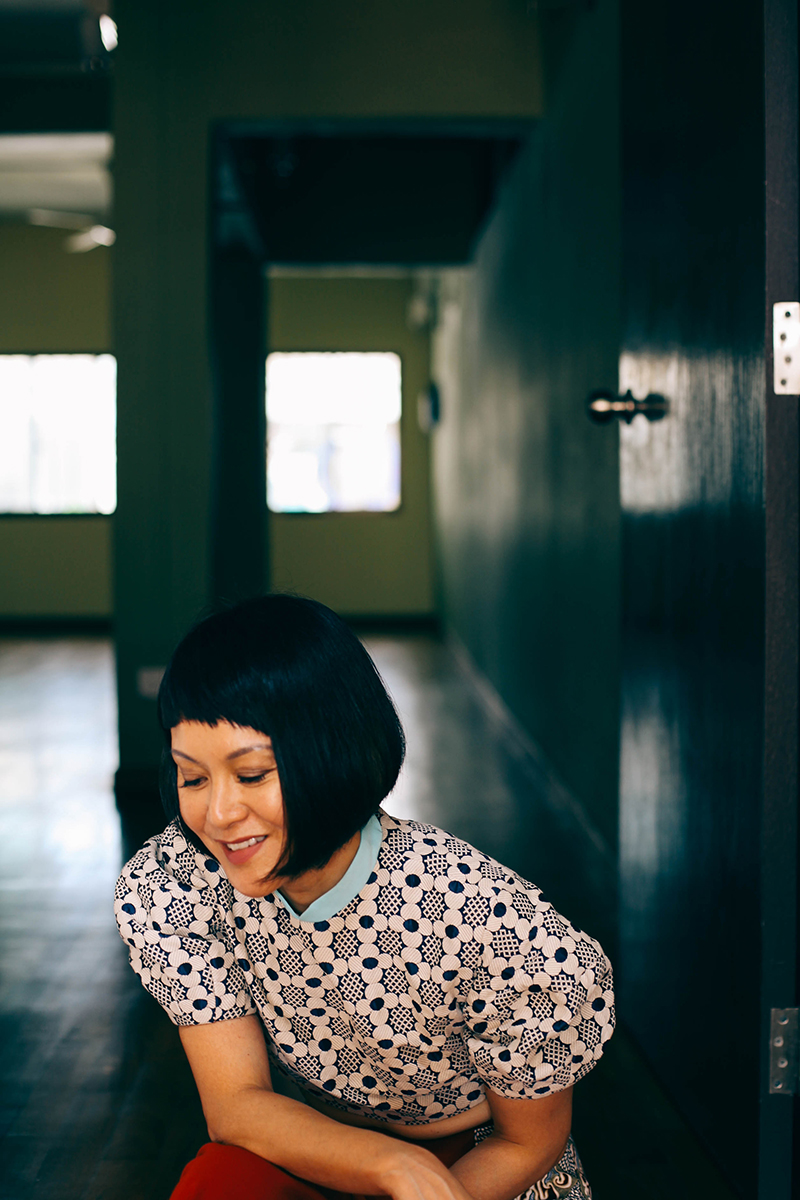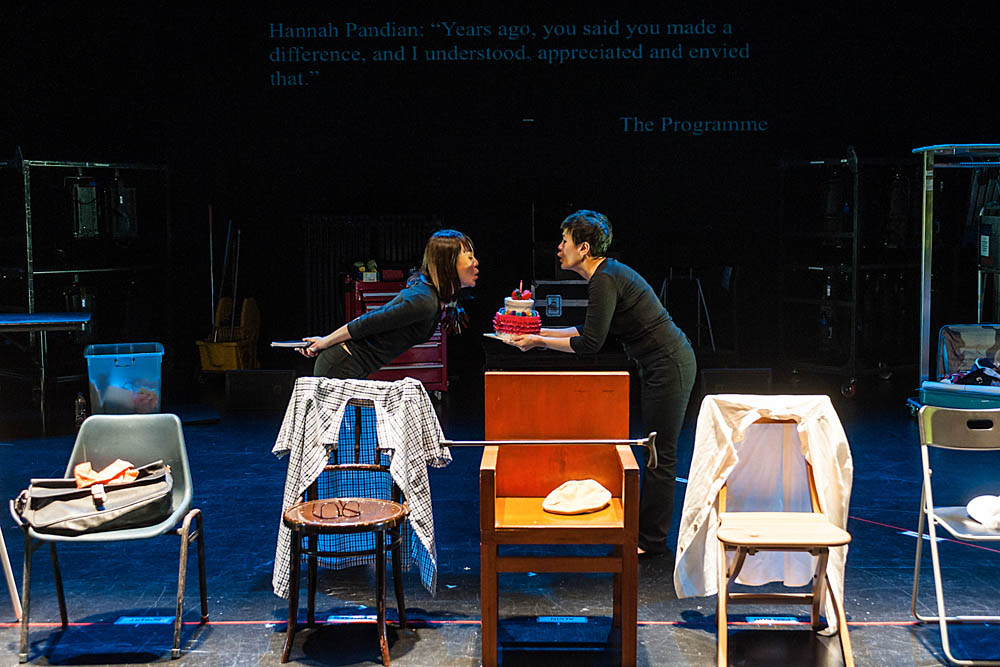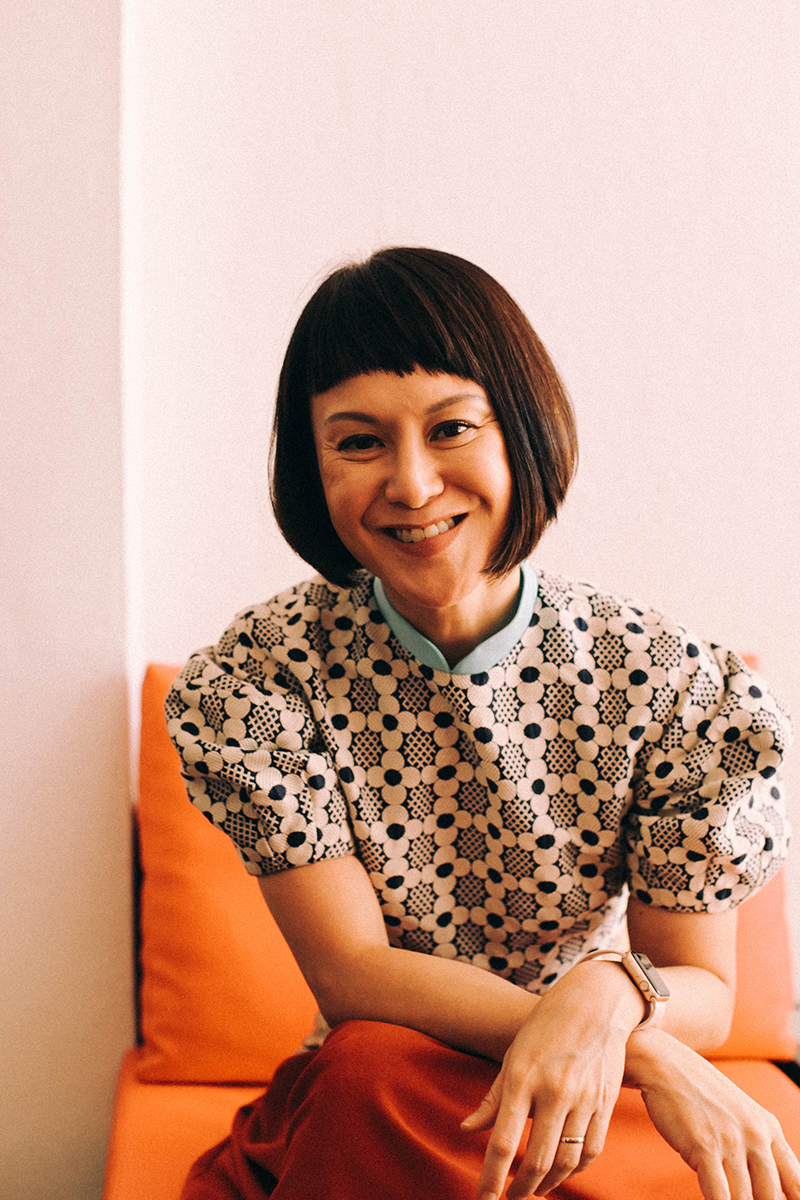A collection of conversations with a diverse range of local and regional creatives
Library Conversations for SGABF2020
We examined the systems that support art book making and independent art book publishing in Singapore and the region.
A Closer Look for SGABF2019
We gathered perspectives on our zine and art book culture, and discuss the possibilities of self-publishing today.
21 Creatives for SGABF2018
We sat down with 21 creatives of various disciplines to learn about their practice and asked each of them to fill up a blank page in a notebook.
JANICE KOH

Photo Credits: SGABF
SGABF: You’ve had to stand on different stages as a (former) Nominated Member of Parliament (NMP) and an actress, which you saw as an important role that acts as a bridge between practitioner and administrator. Were there contradictory principles and functions? If so, how did you balance these responsibilities?
Janice Koh (JK): I think the two roles are really different and yes, sometimes you feel that seeing things from one particular side puts you in opposition to the other. The challenge is always remembering that the end game is the same – which is growing a vibrant art scene and developing artistic talents for Singapore, and telling stories that are meaningful and that resonate with Singaporeans and the world, which will leave a legacy for our country. So that was the challenge whenever we are talking to people on the other side of the table. I guess I just put on different hats; the artist's hat when I am on one end negotiating or discussing something with government, and the government's hat when I am talking to artists because you need to challenge ideas, presumptions and assumptions.
Even though they are in opposition, I never felt conflicted because the end game is always very clear in my head: what is best for Singapore and the art scene now and in the future. When I am talking to creatives or artists, I give them a sense of what I feel officials or governments might say so that we can scenario-plan, then work out how we can manage and interface with that, and how we can assuage people’s uncertainties or fears. It is not that politicians, proletariats, or civil servants do not understand artists, it is that sometimes we hang on to our point of view strongly because that is our job. So I played that role a lot. I think more people can, and should, play that role. Because that’s a way of mediating and bridging differences. Everybody has the same end game, just different ways of getting there.
SGABF: How do you think Singapore’s arts and culture has progressed (or regressed) from a decade ago?
JK: It has moved forward commercially, which means that working in the arts today, more than ever before, has become significantly more financially viable. Taking myself as a barometer, when I first entered, it was just not feasible to do it as a full-time job.
 Picture Credits: W!ldrice
Picture Credits: W!ldriceNow, many people can balance different roles within the industry, make it their full-time job, and make a sustainable income from it.
There are two areas where I feel we have moved backwards. Firstly, in regulation and censorship. We keep moving forwards and back, and we have not really made a lot of progress in terms of opening up and being a lot more light-touch with the way we regulate. It is still very protective and riddled with advisories and ratings which does not really educate the audience as to what they are going to see; it just puts boundaries on what people think they might or might not enjoy. We are taking a shortcut and an easy way out. It is a case of, “Just tell me, should I turn on the channel or not? Should I watch this show or not? Should I walk into this exhibition, and how many nudes are there?” As opposed to, “Why don’t you give it a try, why don’t you read the synopsis and decide for your kids?” I think that we have not nuanced the way we regulate that space, and the artistic space should be one that is groundbreaking and allows people to go past their comfort zones in order to receive new ideas. If you do not go past that comfort zone, you are in your echo chamber; the arts cannot do its job. We think that we are policing the space, but it is a great injustice to Singapore’s artists and residents here because they do not have the chance to take the risk to try something new.
Secondly, we have also moved backwards in terms of the experimental space. In the old days when nothing was commercially viable, it was not a cause for concern if all your shows are a little bit risky, in a black box, and for just 200 people. It was a great time to experiment with form and language and so on. As Singapore becomes a lot more expensive to work and live in, even arts groups find it challenging to build the buffer zone you need to innovate. For example, when you book a theatre, rental is expensive and you cannot be trying out a new playwright, or when you are renting a gallery, you may not want to put up a work that would not sell. So the fringe has reduced quite a lot.
There are parts of the system which has changed for the better, and then there are parts that no longer exist because of economics. The problem can happen in any city, but because Singapore is so small, there are not a lot of fringes to move towards. So, the unpoliced and unlicensed kind of space for something to sizzle and spark and happen organically with no huge financial risks; those kinds of spaces are very few and far between. There are a lot more venue owners and festival organisers to artificially create that. Esplanade Presents: The Studio would approach new directors, producers, and actors and invite them to try new pieces of work.
I think that's great, but in a way, it is like they have to inject that in because otherwise the mini “substations” of Singapore just do not cater to that anymore.
JK: I think that most people think that it is not for them and they can easily live without it. But, I think it depends on your interpretation of the arts because arguably you can say when we hear The Sam Willows on the radio, or watch a film by Anthony Chen, we are consuming the arts in some way. I think it is just a matter of degree.
So when they say that something is very atas and not for them, they have a very specific idea of what art is. Our job is to try to diversify the way we distribute it — not necessarily to dumb it down — I mean making it accessible in terms of pricing, marketing, maybe venues, and slowly try to break those psychological barriers down.
 Photo Credits: Arts Republic
Photo Credits: Arts Republic
JK: The way I go about choosing the work that I do never changes, regardless of my position in parliament. I always felt that I need to keep a sense of integrity to the work that I was doing. In fact, when I was in parliament, I did Cooling Off Day and Fear of Writing, which are both very anti-establishment. So I was already doing a lot of work that was challenging ideas and the status quo. It was important that I continue to choose work that was consistent with how I saw things. You are not getting a shinier, nicer or more pleasant version of me just because I am in parliament. I mean everything I say, and everything that I do outside demonstrates that.
Self-censorship is self-imposed, so there is nothing for me to agree or disagree; it is a choice. I feel that a system that encourages self-censorship will be detrimental to creativity and innovation. At the same time, I can see why some people would self-censor, and it may be for reasons other than politics. They might want to take a scene out or rewrite a sentence to get a PG rating and reach a wider audience. When we say “censorship”, we are referring to things that you would say but you don't due to certain circumstances. If you feel like there is something that you want to say, and for whatever reason feel that you are going to be persecuted because of it, then I think that is a sorry state of affairs, although it does happen. I personally feel that censors have their job, so let them do it. If you submit ten scripts and they censor nine, then stage the tenth one lah!
SGABF: What do you feel is the everyday Singaporean’s general opinion of the arts? And what can be done to improve the accessibility of the arts to them?
JK: I think that most people think that it is not for them and they can easily live without it. But, I think it depends on your interpretation of the arts because arguably you can say when we hear The Sam Willows on the radio, or watch a film by Anthony Chen, we are consuming the arts in some way. I think it is just a matter of degree.
So when they say that something is very atas and not for them, they have a very specific idea of what art is. Our job is to try to diversify the way we distribute it — not necessarily to dumb it down — I mean making it accessible in terms of pricing, marketing, maybe venues, and slowly try to break those psychological barriers down.
 Photo Credits: Arts Republic
Photo Credits: Arts Republic
SGABF: Did your time as an NMP alter the way you approach your practice as an actress? What is your opinion on self-censorship, and do you think that it actually produces adverse results in terms of the “loosening up” of the arts in Singapore?
JK: The way I go about choosing the work that I do never changes, regardless of my position in parliament. I always felt that I need to keep a sense of integrity to the work that I was doing. In fact, when I was in parliament, I did Cooling Off Day and Fear of Writing, which are both very anti-establishment. So I was already doing a lot of work that was challenging ideas and the status quo. It was important that I continue to choose work that was consistent with how I saw things. You are not getting a shinier, nicer or more pleasant version of me just because I am in parliament. I mean everything I say, and everything that I do outside demonstrates that.
Self-censorship is self-imposed, so there is nothing for me to agree or disagree; it is a choice. I feel that a system that encourages self-censorship will be detrimental to creativity and innovation. At the same time, I can see why some people would self-censor, and it may be for reasons other than politics. They might want to take a scene out or rewrite a sentence to get a PG rating and reach a wider audience. When we say “censorship”, we are referring to things that you would say but you don't due to certain circumstances. If you feel like there is something that you want to say, and for whatever reason feel that you are going to be persecuted because of it, then I think that is a sorry state of affairs, although it does happen. I personally feel that censors have their job, so let them do it. If you submit ten scripts and they censor nine, then stage the tenth one lah!

Photo Credits: SGABF
SGABF: What are your hopes for the arts in Singapore? How do you think initiatives like SGABF can help?
JK: I would like to see a lot more independent curation across the board, like art book fairs and festivals, whether it is M1 Singapore Fringe Festival or SIFA, or just people starting their own platforms and democratising the space a little bit more. The space right now is very centrally-controlled, especially by NAC and the Esplanade. It would be great for people taking the ownership and leadership to say, “Well, I can also start my own festival and bring people together, and showcase the talents that are not being showcased in those venues.”
I also really want to see a lot less censorship — that is the biggest thing. Mainly for the authorities to step back and give more space, less intervention and less tying of grants to content, instead to artistic excellence.
A respected stage and television actress, Janice has an Honours degree in Theatre Studies from the National University of Singapore and graduated from the University of London's Goldsmith's College with a Masters with Distinction in Theatre Administration. She won the Life! Theatre Award for Best Actress for her performance in David Auburn's 'Proof' and received Best Actress nominations for her roles in Loo Zihan's 'With/Out', 'Optic Trilogy' by Wild Rice, Pangdemonium's 'Rabbit Hole', and Ovidia Yu's 'Hitting (On) Women'. In 2010, she was nominated Best Actress at the Asian Television Awards for her role in 'The Pupil'. Recent theatre credits include Pangdemonium's 'The Father', 'Frozen' and 'Swimming with Sharks', SRT's 'Hand to God', Ong Keng Sen's 'Sandaime Richard' and 'Fear of Writing', Wild Rice's 'Supervision', 'Another Country', and 'Cooling Off Day', and The Finger Player's 'Poop!' and 'Rant & Rave'. Internationally, Janice has performed at various festivals and performing venues across the world, including the Edinburgh International Festival, the Kunsten Festival des Art in Brussels, Bristol Mayfest, the Shizuoka Performing Arts Festival and the Hamburg Summer Theatre Festival. Janice wrapped filming on Warner Brother's 'Crazy Rich Asians', which will open in theatres in August 2018. Other film credits include Ken Kwek's 'Unlucky Plaza', 'The Faith of Anna Waters' by Kelvin Tong, and 'Agent 47'. Recent television credits include the second season of 'Zero Calling', 'C.L.I.F. Season Two', 'Fighting Spiders' and hosting 'The Art of Conversation' for Channel News Asia. Janice was a former Nominated Member of Parliament, and currently serves on various boards in the non-profit arts and education sector.
© Singapore Art Book Fair 2025. All rights reserved.
For further enquiries, please contact us at info@singaporeartbookfair.org.
Singapore Art Book Fair is organised by
![]()
For further enquiries, please contact us at info@singaporeartbookfair.org.
Singapore Art Book Fair is organised by
